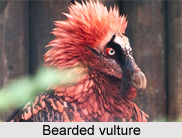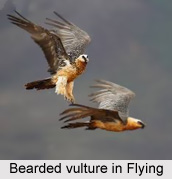 Bearded Vulture with a scientific name "Gypaetus barbatus", also known as the lammergeyer or ossifrage, is a bird of prey and the only member of the genus Gypaetus.
Bearded Vulture with a scientific name "Gypaetus barbatus", also known as the lammergeyer or ossifrage, is a bird of prey and the only member of the genus Gypaetus.
Traditionally considered an Old World vulture, it actually forms a minor lineage of Accipitridae together with the Egyptian vulture (Neophron percnopterus), its closest living relative.
Feedings of Bearded Vulture
Bearded Vulture eats mainly carrion and lives and breeds on crags in high mountains in southern Europe, the Caucasus, Africa, the Indian subcontinent, and Tibet, laying one or two eggs in mid-winter that hatch at the beginning of spring. Populations are resident
Distribution of Bearded Vulture
Bearded Vulture is sparsely distributed across a considerable range. It may be found in mountainous regions from Europe through much of Asia and Africa. In Eurasia, it is found in the Pyrenees, the Alps, the Caucasus region, the Zagros Mountains, the Alborzs, the Altai Mountains, the Himalayas, western and central China, Israel (although the bird has been declared extinct in Israel for the past few decades, unconfirmed sightings have been reported in 2000 as well as 2004 and the Arabian Peninsula. In Africa, it is found in the Atlas Mountains, the Ethiopian Highlands and down from Sudan to north-eastern Democratic Republic of the Congo, central Kenya and northern Tanzania. An isolated population inhabits the Drakensberg of South Africa.
Concentration of Bearded Vulture
Bearded Vulture is almost entirely associated with mountains and inselbergs with plentiful cliffs, crags, precipices, canyons and gorges. They are often found near alpine pastures and meadows, montane grassland and heath, steep-sided, rocky wadis, high steppe and are occasional around forests. They seem to prefer desolate, lightly-populated areas where predators who provide many bones, such as wolves and golden eagles, have healthy populations. In Ethiopia, they are now common at refuse tips on the outskirts of small villages and towns. Although they occasionally descend to 300-600 meters, bearded vultures are rare below an elevation of 1,000 m and normally reside above 2,000 meters in some parts of their range. They are typically found around or above the tree line which are often near the tops of the mountains, at up to 2,000 m in Europe, 4,500 m (14,800 ft) in Africa and 5,000 m in central Asia. They even have been observed living at altitudes of 7,500 m (24,600 ft) on Mount Everest and been observed flying at a height of 24,000 ft (7,300 m).
 Colours of Bearded Vulture
Colours of Bearded Vulture
Bearded Vulture does not have a bald head. This species is relatively small headed, although its neck is powerful and thick. It has a generally elongated, slender shape, sometimes appearing bulkier due to the often hunched back of these birds. The gait on the ground is waddling and the feet are large and powerful. The adult is mostly dark grey, rusty and whitish in colour. It is grey-blue to grey-black above. The creamy-coloured forehead contrasts against a black band across the eyes and lores and bristles under the chin, which form a black beard that give the species its English name. Bearded vultures are variably orange or rust on their head, breast and leg feathers but this is actually cosmetic. This colouration may come from dust-bathing, rubbing mud on its body or from drinking in mineral-rich waters.
Feathers of Bearded Vulture
Bearded Vulture has the tail feathers and wings are grey. The juvenile bird is dark black-brown over most of the body, with a buff-brown breast and takes five years to reach full maturity. The lammergeier is silent, apart from shrill whistles in their breeding displays and a falcon-like cheek-a-cheek call made around the nest.











